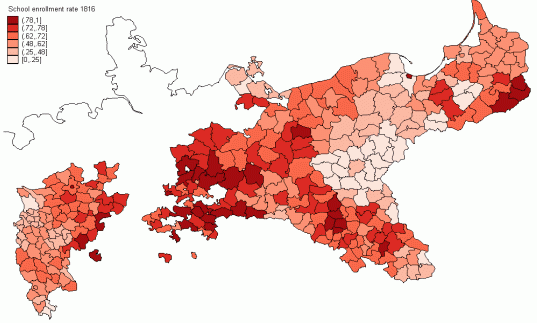The Industrial Revolution was British, which is why British evidence sets the received wisdom on the Industrial Revolution. Consequently, the received wisdom in the literature is that – contrary to economic growth in the 20th century – formal education had no role in economic development during the Industrial Revolution (Mitch 1993 and Mokyr 1990).
But while the developments in England were promoted by various factors (e.g. on this site Allen 2009 stresses the role of low energy prices and high wages) or might even have been rather accidental, they have been somewhat different on the European continent. When new machines and work processes became available in England, other countries just had to copy them. The adoption of English techniques and machines was therefore crucial to catch up to the technological frontier. But the pre-conditions were not equal for all. Some regions just had too little education for immediate adoption. So far, the literature has given little attention to the role of education in the catch-up of technological follower nations during the Industrial Revolution.
In our recent work (Becker et al. 2009), we argue that formal education was necessary for the adoption of the new technologies and thus became crucial for the economic catch-up of technological follower nations. Our empirical evidence based on regional industrialisation patterns in 19th-century Prussia supports this hypothesis.
Our argument starts from theoretical models of technological diffusion in the spirit of Nelson and Phelps (1966). Our model suggests that education is the key ingredient to absorb new technologies and adapt to change. To test whether this was indeed the case during the Industrial Revolution, we take advantage of the fact that the Prussians were meticulous data gatherers. The Prussian Statistical Office conducted a string of full population, factory, occupation, and school censuses over the course of the 19th century. Descending into several archives, we managed to compile a historically unique micro-regional panel dataset of 334 Prussian counties spanning from 1816, before the Industrial Revolution got started in Prussia (generally placed around the mid-1830s; e.g., Tilly 1996) to the end of the first phase of industrialisation in 1849 and the second phase in 1882.
Our results show that education played an important role for industrialisation during the first phase of the Industrial Revolution. Prussian counties that were better educated in 1816, before the start of the Industrial Revolution, responded more successfully to the opportunities created by the outside technological changes from Britain. The importance of education even increased from the first to the second phase. Without its high average educational attainment, industrial employment might have been a third lower during the first phase in Prussia, and possibly even lower during the second phase.
Prussian reform
Between her defeat by Napoleon’s armies in 1806 and the rearrangement of European borders in 1815, Prussia had started to reform herself and to provide more freedom to the people. Farmers went from serf to subject and became able to possess their own land, the influence of the guilds was trimmed, occupational choice became free, and internal tariffs were successively abolished. These reforms paved the way for Prussia to become an industrial country. However, the Industrial Revolution was a regional phenomenon (Pollard 1984) – and regional differences in industrialisation cannot be explained by reforms that applied to the whole country. This is why we draw our evidence from Prussian county-level data.
As early as 1763, Frederick the Great had published a regulation that contained an explicit general invitation for all Prussian citizens to attend school. By 1816, Prussia had become the world leader in primary schooling (see Lindert 2004) with an average per-county enrolment of 58% among the 6 to 14 year old. Nevertheless, there was strong regional variation in enrolment rates. The county with the lowest enrolment only sent 3% of its children to school in 1816, while it was 95% in the county on the other end of the distribution (Figure 1). In 1849, Prussian enrolment rates had reached an average of 80%. Subsequently, in 1871 we observe an average literacy of 84% in the adult population.
Figure 1. School enrolment rates across Prussian counties in 1816
We can measure industrialisation by the share of the population employed in industrial production. Towards the end of the first phase of the Industrial Revolution in 1849, factory production was still unusual. Our unique Prussian censuses distinguish 119 types of factories, where an average of 1.8% of the total county population was employed. Still, there were counties like Iserlohn, famous for its large-scale metalworking factories, where already 16.5% of the population was employed in factories. In total, textile factories (not counting hand-driven looms) employed one sixth of the factory workers on average, metal factories one third, and all other factories (e.g., those producing food, paper, rubber, and wood) one half. Towards the end of the second phase of the Industrial Revolution in 1882, manufacturing had reached an average employment of 12% of the total population (4% in textiles, 3% in metals, and 5% in other industries).
Establishing causality
When analysing the role of education in the Industrial Revolution, the direction of causation is not straightforward. It might be that factory production increased the demand for low-skilled and child labour and thus kept children out of school. On the other hand, increasing living standards might have made education more affordable for the broad masses, so that more children would have been sent to school. Both examples imply that the causation might also run from industrialisation to schooling.
To account for this possibility, our study emphasises that it was the level of pre-industrial education that was important for technology adoption – not the growth of education during the Industrial Revolution. We therefore devise an empirical strategy that makes use of only that part of the educational variation observed during the two phases of the Industrial Revolution that can be traced back to educational variation that could already be observed in 1816, long before the real start of the Industrial Revolution in Prussia. We also use several historical examples to argue that the education level observed before the onset of industrialisation had emerged from historical idiosyncrasies.
Still, we additionally worry that industrialisation may have been facilitated by the level of pre-industrial development, so that more developed counties were able to achieve high enrolment rates and were successful in industrialising for the same reason. We therefore take into account the pre-industrial level of development of the counties. We make sure that our results are not driven by differences in pre-industrial endowments such as natural resources, proto-industrial techniques, urbanisation, demography, agricultural orientation, public infrastructure, religion, landownership, and geography. By doing so, we try to distil the causal influence of education on industrialisation.
Our results are further supported when we use our three points in time – 1816, 1849, and 1882 – in a longitudinal analysis that ignores any differences in levels across counties. Yet another approach to identification that corroborates our findings uses distance to Wittenberg as an alternative source of educational variation, exploiting the fact that the 16th-century concentric spread of Protestantism in Prussia gave rise to educational variation, owing to Luther’s urge that each Christian should be able to read the Bible (Becker and Woessmann 2009).
Sector and educational differences
The aggregate result of the importance of education for industrialisation conceals important sector differences, though. It turns out that in the textile industry, where innovation was less disruptive and child labour more prevalent, education had no effect in either phase of industrialisation. The literature often confirms that the development in textiles was different, because of path dependence, high sunk costs, and child labour. Industrial development in the non-textile sectors, which experienced more radical change or even evolved all new, depended on the availability of an educated population that was earlier aware of the productive potential of new technologies and more capable of adjusting to changed situations. The general basic education implemented by Humboldt in Prussia, which aimed at creating independent rational thinking and self-responsible action among the broad masses then became important to learn how to follow and to understand the new technological developments. In line with this, we find significant effects for basic education, but not for upper-secondary and higher education.
Conclusion
When testing whether initially better-educated Prussian regions caught up faster to the technological leader England, we find evidence that formal education facilitated industrialisation. Thus, when looking beyond the British Industrial Revolution to industrial catch-up of technological follower nations – the whole world except Britain – and beyond the textile industry (where most of the British evidence comes from), education turns out to be a leading factor for economic development. In terms of the adoption of new technologies (rather than their subsequent use in production when they have become standard), human skills may have been a complement to new technologies not only since the early 20th century, as shown by Goldin and Katz (2008), but even earlier. Education played a much larger role both in the first and the second phase of the Industrial Revolution outside Britain than most assessments based on the current state of empirical evidence seemed to suggest. In the end, it may not be a coincidence that Prussia, the educational world leader at the time, was particularly successful in the catch-up phase of industrialisation.
References
Allen, Robert C (2009), “Why was the Industrial Revolution British?”, VoxEU.org, 15 May.
Becker, Sascha O and Ludger Woessmann (2009), “Was Weber Wrong? A Human Capital Theory of Protestant Economic History”, Quarterly Journal of Economics, 124(2):531-596.
Becker, Sascha O, Erik Hornung, Ludger Woessmann (2009), “Catch Me If You Can: Education and Catch-up in the Industrial Revolution”, CESifo Working Paper 2816, Munich:CESifo.
Goldin, Claudia and Lawrence F Katz (2008), The Race between Education and Technology, Cambridge: Harvard University Press.
Lindert, Peter H (2004), Growing Public: Social Spending and Economic Growth since the Eighteenth Century, Two volumes, Cambridge University Press.
Mitch, David (1993), “The Role of Human Capital in the First Industrial Revolution”, In: Joel Mokyr (ed.), The British Industrial Revolution: An Economic Perspective, 267-307, Boulder:Westview.
Mokyr, Joel (1990), The Lever of Riches, Oxford University Press.
Nelson, Richard R, Edmund S Phelps (1966), “Investment in Humans, Technological Diffusion, and Economic Growth”, American Economic Review, 56(2):69-75.
Pollard, Sidney (1981), Peaceful Conquest: The Industrialization of Europe 1760-1970, Oxford University Press.
Tilly, Richard H (1996), “German Industrialization”, in Mikuláš Teich, Roy Porter (eds.), The Industrial Revolution in National Context: Europe and the USA, 95-125, Cambridge University Press.





